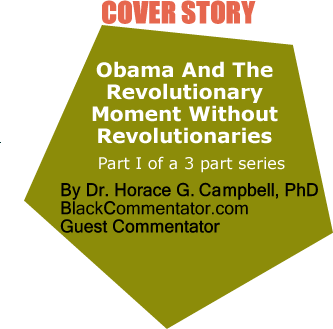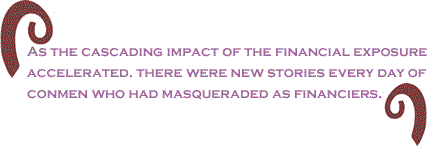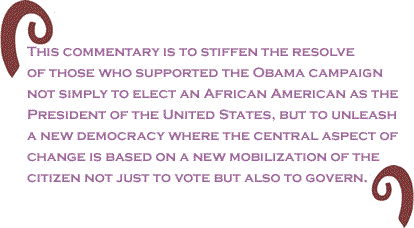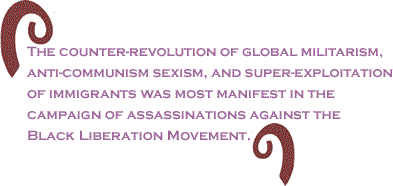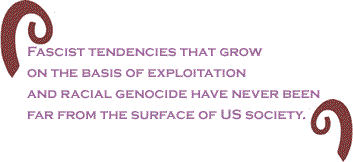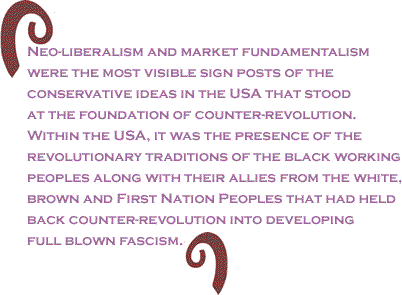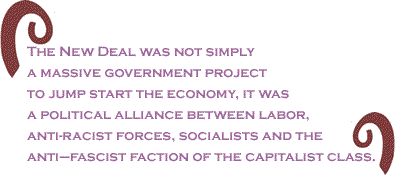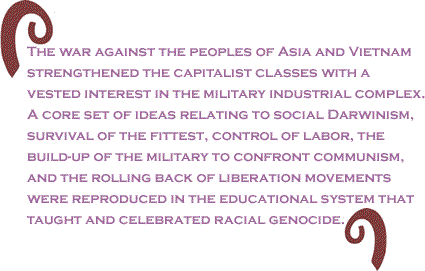
|
|||||||||||||||||||||||

Custom Search
|
|
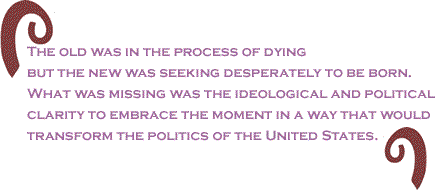 |
|
|
Introduction There was happiness all over the world on Wednesday morning November 5 as the world woke up to the victory of Barack Hussein Obama in the campaign to become the President of the United States. US citizens, in the main, rejected neo- conservatisms and neo-liberalism. The team around Obama had organized the most sophisticated election campaign in the history of the United States, breaking the old conventional wisdom about red and blue states and the divisions between black, brown, first nation and white workers. The political organization of this ‘machinery of hope’ had tapped into the deep spiritual energies of people who wanted change. Rituals of hope were translated into effective tools for inspiring a new generation that had been alienated by the old politics of manipulation and exclusion. Songs of hope echoed from across the USA to different parts of the world using the new media to make this election a referendum on the future of global humanity. Barack Obama has been called a transformative figure and a transcendental figure by many commentators but it is important to grasp the moment that made Obama the person best able to tap into the turning point away from the old politics of the nineteenth and twentieth centuries. Barack Obama and his team had grasped the need to catch up with the technological change and the revolutionary potentialities of the moment. Obama’s election took place in the middle of the push forward to the era of singularity. This is the era were the convergence of information technological tools and the human brain will reach a new level. Unfortunately, many of the scientists working on these new possibilities have been trained in the era of ‘white nationalism’ and concepts of the hierarchy of human beings. The convergence of biotechnology, nanotechnology, information technology and cognitive technology had opened the possibilities for profound transformations of the relations between humans and the relations between humans and nature. Intentional actions by humans to live in harmony in nature and with each other opened revolutionary possibilities for wealth creation and for global eradication of exploitation, racism and gender discrimination. Yet, trapped by the ideas and conventions of liberalism and neo-liberalism, the Obama transition to the top office in the USA was torn between the past forms of economic organization and the multiple challenges of breaking from the old forms of destruction, war and greed. Messages of change, hope and peace during the election campaign had resonated with a population that wanted an end to war, militarism, fear and economic terrorism. Environmental destruction, waste, toxic dumps and toxic assets reinforced the cancers of sexism, racism, homophobia and economic exploitation. These are the elements of counter-revolution that had been set in motion after the Civil Rights Revolution in the United States. The election results of 2008 with the landslide victory of Barack Obama flowed from decades long struggles to democratize US society. The old was in the process of dying but the new was seeking desperately to be born. What was missing was the ideological and political clarity to embrace the moment in a way that would transform the politics of the United States. The urgency of the moment could not await the intellectual and ideological maturation of the citizens of the United States. Forced by the weight of fallout from the conservative and neoliberal ideas about market fundamentalism, the US government nationalized financial institutions (banks and insurance companies) with a massive intervention to save the automobile industry. Because of the ideological lag from the Reagan counter-revolution, the mainstream media and the intelligentsia could not easily use the word ‘nationalization.’ Henry Paulson termed the moves, ‘conservatorship.’ This word was more palatable to a class that had created a fictional financial system that rested on the confidence in the US military might. From across the Atlantic, the former Mayor of London, Ken Livingstone commented that the pace of nationalization in the USA and Britain was the fastest in history outside of a revolution. Whether it was called conservatorship or nationalization the real change that was urgent was for citizens to become engaged with these new state institutions so that democracy was not confined to elections. Democratic control and accountability by workers at the nationalized entities would strengthen democracy and democratic participation. As the consequences of the military defeat of the USA in Iraq became clearer, the quicksand of get-rich schemes on Wall St (termed the financial services industry) evaporated with the schemes called ‘credit default swaps’ and ‘collateral debt obligations’ exposed to be fraudulent gambling schemes of humans who were inspired by greed. As the cascading impact of the financial exposure accelerated. there were new stories every day of conmen who had masqueraded as financiers. The recursive process of scandal begetting scandal and scams exposing other scams behind the so called ‘financialization’ and ‘securitization’ took place at such a breathtaking speed that the media had no time to hide the depth of the crisis form the working peoples. Not
just in the USA, but internationally, the corrosive repercussions
of Bernard Madoff’s ponzi scheme with the loss of $50 billion dollars
for ‘investors’ further eroded confidence in US capitalism. In
In this cascading quagmire, sections of the US establishment
began to understand that it was the politics of Barack Obama that
could save the social system. Hence, during the transition, even though
Obama said that there was only one President, the media managers
understood the need for his face to give confidence, so he was paraded
on television every day. This portrayal of Obama as the steady leader
could not hide the news about bail Citizens from all corners of the world joined with those in the United States who were nurturing the birth of the new twenty first century politics. The expectations from this Obama victory triggered new possibilities as workers looked to the Obama administration to reinvigorate interest in the rights of workers in all parts of the world. As with workers in Chicago, the youth began to be released from the fears, insecurities and phobias that had been rained on them by the media and the image makers of the military/industrial/cultural/petroleum complex. Here was one crack in the edifice of mind control. Would the crack in the edifice of mind control unleash a new cultural apparatus in the USA? This break was not only possible but slowly developing even before the inauguration as those media outlets that had enthusiastically supported the militarism of the War on Terror now open the airwaves to new voices and now social groups. All of the contradictions before the society were now being discussed as those who had surrounded Obama now jockeyed for positions in the new administration. This commentary is to stiffen the resolve of those who supported the Obama campaign not simply to elect an African American as the President of the United States, but to unleash a new democracy where the central aspect of change is based on a new mobilization of the citizen not just to vote but also to govern. Alice
Walker called on the President to govern with happiness. Reflecting
on the positive mood inspired by Obama on the night of the election
an
How can the progressive movement build on the spirit of happiness and revolution in the midst of an economic depression? This was the challenge of the progressive forces who carried forth the spirit of optimism of those who had fought against historic oppression.
We
will begin outlining the elements of the counter-
The peace and justice forces have been able to withstand the neo-conservative onslaught embedded in the imperial war on terror. In the concluding section, this author will seek to grasp how is it that citizens in the USA were caught in a revolutionary moment without revolutionaries. It will be the argument that in so far as the counter- revolutionary ideas of fundamentalism, (religious, military and economic) sought to blunt alternative ideas about social and economic life, the realities and tragedies of hurricane Katrina, the health crisis and cancer epidemic were bringing forth new ideas.
What is necessary is for the old left to develop some self- Obama’s victory in the context of counter-revolution. Samir Amin, in his book, The Liberal Virus: Permanent War and the Americanization of the World, sounded a warning about the possibilities of genocide of epic proportions if humanity followed the logic of neo-liberalism that sought to change agriculture around the world to follow the forms of agricultural production of Western Europe and North America. “Peasant agriculture, accounting for 3 billion humans, faces economic extermination by 20 million modern farms”, he warned in this book.
Neo-liberalism
and market fundamentalism were the most visible sign
German society is widely known as the high point of the degeneration from counter–revolution to full blown fascism in the 20th century, but many of the economic, social and intellectual underpinnings of German fascism had their origins in the eugenics movement in the United States. No less a person than the President of the United States, Theodore Roosevelt had expressed the most fascist ideas when he argued that,
Averell Harriman (former Governor of NY and one of the most important leaders in the Democratic Party for over 50 years) grew up in a household where his mother was the main financial supporter for the Eugenics Records Office at the Cold Spring Harbor Laboratory. This was the center for research on eugenics and human heredity. So potent were the ideas of eugenics in the USA that even leaders of the Women’s movement who were struggling for the right to vote subscribed to the fascist ideas of eugenics. Margaret Sanger said, "Eugenics is … the most adequate and thorough avenue to the solution of racial, political and social problems.” These statements reveal the reality that genocidal thinking was never absent form US society. Genocidal thinking as manifest in the US eugenics movement is the kind of thinking that devalues the lives of other human beings on the basis of their race or ethnicity. Just when concerned citizens were inquiring as to whether there were linkages between the Eugenics research at the start of the century and the new directions from the Human Genome Project at Cold Spring Harbor, James D. Watson made the clear statement in 2007 that the Africans were less intelligent than Europeans. As a Nobel Prize winner in medicine and one time head of the Cold Springs Harbor Laboratory, Watson was bringing his considerable scientific reputation to consolidate scientific racism in the community of those involved in genetic engineering. Eugenics
had graduated from the death camps of the Germans to the white lab
coats of research parks across Universities in the United States.
Universities were competing for start-
The US society had been able to escape the worse aspects of the capitalist depression of the thirties because a progressive coalition had supported the Democratic Party and the administration of Franklin Delano Roosevelt. This was the anti-racist coalition that turned its back on the segregationists that had dominated the Democratic Party between1865 and 1933. It is not by accident that in preparation for his role as the President of the United States, Obama is preparing his administration for massive state intervention and infrastructure projects similar to the New Deal. The New Deal was not simply a massive government project to jump start the economy, it was a political alliance between labor, anti-racist forces, socialists and the anti–fascist faction of the capitalist class. Ultimately, it was military Keynesianism that broke the depression but blacks had to fight a prolonged and protracted struggle against the chauvinistic and racist ideas that formed the basis of the liberal ideology of US capitalism. Space does not allow for an elaboration of the protracted struggles from the fight against fascism globally, but it is important to restate the fact that imperialism, militarism and expansionism thrived inside the United States after World War II. As early as the fifties, when President Dwight Eisenhower had warned of the rise of the Military Industrial Complex, the sociologist C. Wright Mills had written in his book of the development of the Permanent War economy and the interlocking directorates between the military, the economic and the political elite. Mills also very early outlined how the military industrial complex was corrupting the mission of the University so that the eugenics thinking within the society reinforced the devaluation of other humans while celebrating free markets. Militarism, the Breton Woods Institution and US Imperialism Both imperial wars of the twentieth century had been precipitated by the challenges of German capitalists to the dominance of the British imperialists. One by-product of British imperialism and militarism was the centrality of the British Currency (the Pound sterling) as the currency of world trade. In the midst of fighting fascism in Germany there were concerns in the United States for the reconstitution and the recomposition of global capitalism after the war. Thus, in 1944, the Breton Woods system was instituted so that the USA could become the international headquarters of capitalism. The establishment of the International Monetary Fund (IMF) and the International Bank for Reconstruction and Development (IBRD) or the World Bank – entrusted the defence of international capitalism in the hands of the US ruling class. The dollar was enshrined as the currency of world trade (replacing sterling) and the USA used the strength of the dollar to support the reconstruction of capitalism in Western Europe.
Despite the competition between US and European capitalists, the USA supported European Reconstruction under the Marshall Plan to wean the European working classes away from ideas of socialism and new modes of organizing economic life. The dollar as the reserve currency of the international trading system was aligned to the British pound and this cemented the special relationship between the USA and Britain. Under the articles of agreement of the IMF, the USA was supposed to maintain the value of the dollar at US $35 to an ounce of gold. This arrangement held until the USA exhausted itself in its attempt to roll back the decolonization process, manifest in the struggles against the peoples of Vietnam. The Civil Rights movement
and the rise of counter- The war against the peoples of Asia and Vietnam strengthened the capitalist classes with a vested interest in the military industrial complex. A core set of ideas relating to social Darwinism, survival of the fittest, control of labor, the build-up of the military to confront communism, and the rolling back of liberation movements were reproduced in the educational system that taught and celebrated racial genocide. African Americans had to wage a concerted struggle in the streets, in the factory, at the voting booth and in schools for the rights that had been enshrined in the UN Universal Declaration of Human Rights. These struggles for social and economic rights were designated as a component of the Civil Rights revolution and the Obama electoral campaign was a direct beneficiary of many of the ideas, strategies and tactics that had been developed in the struggles for the Civil Rights Act of 1964 and the Voting Rights Act of 1965. Cultural artists captured the continuities between the Civil Rights Revolution as they wailed, “Rosa Parks sat so Martin Luther King could walk" "Martin Luther King walked so Obama could run." Kwame Ture had forewarned of the linkages between the Civil Rights Revolution and the future revolutionary trajectory of the United States in the book, Ready for Revolution. The counter-revolution of global militarism, anti-communism sexism, and super-exploitation of immigrants was most manifest in the campaign of assassinations against the Black Liberation Movement. The assassination of Martin Luther King Jr. Malcolm X, school children, church goers, Robert Kennedy, John F. Kennedy and the Cointelpro frame up and street killings were meant to halt the coalescence of the Black Liberation movement with the revolutionary traditions of the USA. This counter-revolutionary period had a base in the intellectual culture of the society and found a political base in Reaganism. It was appropriately called the Reagan Revolution. As this counter revolution deepened, Newt Gingrich proudly called himself a revolutionary. In his book on the Bush administration, What Happened: Inside the Bush White House and Washington’s Culture of Deception, Scott McClellan outlined the plans of Donald Rumsfeld, Dick Cheney and the neo-cons for a permanent campaign or permanent revolution It was the peace movement nationally and globally that intervened in the permanent campaign. Historically, the Black Liberation movement had served as an inspiration for the anti-war movement, the peace movement, the Free speech movement, the gay and liberation movement, the women’s movement, the environmental justice movement, the anti- colonial movements (eg Puerto Rico and anti-apartheid) and sections of the workers movement. These movements did not agree on a strategy for liberation but it was understood that the capitalist mode of production stood as an obstacle to human freedom, self-emancipation and limited independence. Through the culture of the Civil Rights movement, the US media was beamed all across the world so that cultural heroes such as Mohammed Ali was not simply an American hero but a hero to all anti- imperialist forces.
Subsequent to the defeat of the USA in Vietnam, the counter-revolutionary forces set out to roll back the gains of the Civil rights period. Professor Ronald W. Walters has chronicled the various policies of the conservative forces in his book, White Nationalism-Black Interests: Conservative Public Policy and the Black Community. Professor Walters correctly documented how the radical section of the conservative movement captured power in the United States and drew attention to how the Clinton administration strengthened these conservative forces. The conservative sections of the capitalist class invested in think tanks and foundations to recast the free market ideas of neo-liberalism. The Heritage Foundation and the American Enterprise Institute emerged slowly during the period of Ronald Reagan to settle at the apex of a network of foundations, publications, columnists, radio talk show hosts, religious organizations, professional fund-raisers, and endowed professors to promote the ideas of white supremacy and obscene militarism. The basic dogma of both conservatism and neo-liberalism was based on the strength of the military and the fight against communism. After the fall of the planned economies in Eastern Europe in 1989, the intellectuals of the conservative movement in the USA were emboldened to believe in the supremacy of the US form of organizing economic life. By the end of the twentieth century, capitalism was presented as a religion with the market as the ‘deity of choice.’ It was in this euphoria over the triumph of capitalism when Harvey Cox penned, ‘the Market as God.’ Throughout this period of the massive buildup of US military, the European capitalists who had been crushed during Second World War set about the establishment of the European Union in order to establish a common currency to compete with the dollar as the currency of world trade. After the massive deficits of the US government, the Europeans refused to continue to finance the US deficits. As long as the dollar was the currency of world trade, the USA could finance its deficits by printing money and by militarily occupying other countries to reinforce US cultural domination. The conflict and cooperation between the European Union and the USA was camouflaged but after the convergence of the European economies with a common currency, the Euro (in 2002), the competition between the USA and Europe was out in the open as the EU sought to develop another imperial front in the international system. Cultural imperialism reinforced the US corporations as the film and media complex was placed at the service of those who promoted genocidal thinking and militarism. Ronald Reagan, as an actor, cemented the linkages between militarism and the media during his rise to power and his actual service as President 1981-1988. Republican-style attacks and negative campaign tactics were introduced into corporate public relations as an essential ingredient of eugenics and mind control. One central component of mind control was to induce fear and pessimism in the ranks of the most oppressed. The genius of the election Obama campaign was to make a leap beyond the cynicism and callousness of the rulers who believed that the oppressed could be divided forever. The Audacity of Hope was translated from a book project
into a ground operation that intervened to halt the permanent campaign
of Within this period there were conservative elements that were proud to be called imperialists. Of these formations, the Project for a New American Century (PNAC) led by Donald Rumsfeld and Richard Cheney called on conservatives to be proud of being imperialist and were not afraid to declare that the United States was above international law. The varying writers who proclaim the need for US imperialism are documented in the book, The New Imperialism by David Harvey. This author wants to go beyond David Harvey and note that the one section of the academic left has been unwilling to grasp the full dangers that have been outlined in the Liberal Virus. Academic treatises on imperialism treated the wars in Afghanistan and Iraq as bad decisions of a neo- conservative cabal instead of understanding this militarism and war as emanating directly from the permanent war culture.
Chris Hedges linked this permanent war culture to the Christian right and the culture of despair in order to promote the American fascists. In his brilliant clarification off the signposts of American fascism, Hedges highlighted the ‘cult of masculinity,’ the religious crusades, the war on truth and the commercialization of God as the key sign posts of American fascism. This author would agree with these signposts with the qualification that the vibrant peace movement, the abolish prison movements, the black liberation movement, the reparations movement, the women’s movement and the environmental justice movement developed as a counterweight to fascism. Hence this author termed the period not as fascist but one of counter-revolution. There were key elements to this counter-revolutionary period.
It should be noted that the identified elements of counter-revolution–militarism, war, eugenics, institutionalized racism, Ritalin culture, environmental decay and toxic racism, propaganda and psychological warfare, economic disparities, bell curve ideas of schooling, re-segregation, sexism and homophobia–cannot be understood in isolation. Within this counter-revolutionary period militarists and anti-democratic forces thrived in all parts of the world. Because of the degree of concentration of capital that had been reached, the counter- revolutionary politics of the one per cent of billionaires on Earth imposed the politics of retrogression and negative human relations not only for citizens of the USA but for most of humanity. In the process there was a vast array of institutions that were organized to demobilize and disorganize the citizens of the world. BlackCommentator.com Guest Commentator, Dr. Horace Campbell,
PhD, is Professor of African American Studies and Political Science
at |
|
Any BlackCommentator.com article may be re-printed so long as it is re-printed in its entirety and full credit given to the author and www.BlackCommentator.com. If the re-print is on the Internet we additionally request a link back to the original piece on our Website. Your comments are always welcome. eMail re-print notice
If you send us an eMail message we may publish all or part of it, unless you tell us it is not for publication. You may also request that we withhold your name. Thank you very much for your readership. |
|
| |
|





























